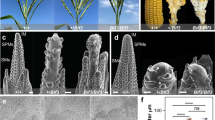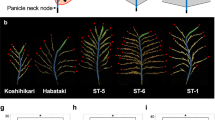Abstract
Setaria viridis is a rapid-life-cycle model panicoid grass. To identify genes that may contribute to inflorescence architecture and thus have the potential to influence grain yield in related crops such as maize, we conducted an N-nitroso-N-methylurea (NMU) mutagenesis of S. viridis and screened for visible inflorescence mutant phenotypes. Of the approximately 2,700 M2 families screened, we identified four recessive sparse panicle mutants (spp1–spp4) characterized by reduced and uneven branching of the inflorescence. To identify the gene underlying the sparse panicle1 (spp1) phenotype, we performed bulked segregant analysis and deep sequencing to fine map it to an approximately 1 Mb interval. Within this interval, we identified disruptive mutations in two genes. Complementation tests between spp1 and spp3 revealed they were allelic, and deep sequencing of spp3 identified an independent disruptive mutation in SvAUX1 (AUXIN1), one of the two genes in the ∼1 Mb interval and the only gene disruption shared between spp1 and spp3. SvAUX1 was found to affect both inflorescence development and root gravitropism in S. viridis. A search for orthologous mutant alleles in maize confirmed a very similar role of ZmAUX1 in maize, which highlights the utility of S. viridis in accelerating functional genomic studies in maize.
This is a preview of subscription content, access via your institution
Access options
Access Nature and 54 other Nature Portfolio journals
Get Nature+, our best-value online-access subscription
$29.99 / 30 days
cancel any time
Subscribe to this journal
Receive 12 digital issues and online access to articles
$119.00 per year
only $9.92 per issue
Buy this article
- Purchase on Springer Link
- Instant access to full article PDF
Prices may be subject to local taxes which are calculated during checkout


Similar content being viewed by others
References
Emerson, R. A. The inheritance of certain ‘Abnormalities’ in maize. J. Hered. 8, 385–399 (1912).
Ray, D. K., Mueller, N. D., West, P. C. & Foley, J. A. Yield trends are insufficient to double global crop production by 2050. PLoS ONE 8, e66428 (2013).
Schnable, J. C. & Freeling, M. Genes identified by visible mutant phenotypes show increased bias toward one of two subgenomes of maize. PLoS ONE 6, e17855 (2011).
Koornneef, M. & van der Veen, J. H. Induction and analysis of gibberellin sensitive mutants in Arabidopsis thaliana (L.) heynh. Theor. Appl. Genet. 58, 257–263 (1980).
Redei, G. P. Arabidopsis as a genetic tool. Annu. Rev. Genet. 9, 111–127 (1975).
Gallavotti, A. et al. The role of barren stalk1 in the architecture of maize. Nature 432, 630–635 (2004).
McSteen, P. et al. Barren inflorescence2 encodes a co-ortholog of the PINOID serine/threonine kinase and is required for organogenesis during inflorescence and vegetative development in maize. Plant Physiol. 144, 1000–1011 (2007).
Wolfe, K. H., Gouy, M., Yang, Y. W., Sharp, P. M. & Li, W. H. Date of the monocot-dicot divergence estimated from chloroplast DNA sequence data. Proc. Natl Acad. Sci. USA 86, 6201–6205 (1989).
Brutnell, T. P., Bennetzen, J. L. & Vogel, J. P. Brachypodium distachyon and Setaria viridis: model genetic systems for the grasses. Annu. Rev. Plant Biol. 66, 465–485 (2015).
Brutnell, T. P. Model grasses hold key to crop improvement. Nat. Plants 1, 15062 (2015).
Schnable, J. C., Freeling, M. & Lyons, E. Genome-wide analysis of syntenic gene deletion in the grasses. Genome Biol. Evol. 4, 265–277 (2012).
Kellogg, E. Floral displays: genetic control of grass inflorescences. Curr. Opin. Plant Biol. 10, 26–31 (2007).
Sreenivasulu, N. & Schnurbusch, T. A genetic playground for enhancing grain number in cereals. Trends Plant Sci. 17, 91–101 (2012).
Jiang, H., Huang, P. & Brutnell, T. P. in Genetics and Genomics of Setaria (eds Doust, A. & Diao, X. ) 303–322 (Springer, 2016).
Michelmore, R. W., Paran, I. & Kesseli, R. V. Identification of markers linked to disease-resistance genes by bulked segregant analysis: a rapid method to detect markers in specific genomic regions by using segregating populations. Proc. Natl Acad. Sci. USA 88, 9828–9832 (1991).
Takagi, H. et al. Mutmap accelerates breeding of a salt-tolerant rice cultivar. Nat. Biotechnol. 33, 445–449 (2015).
Swarup, R. et al. Structure-function analysis of the presumptive Arabidopsis auxin permease AUX1. Plant Cell 16, 3069–3083 (2004).
Yang, Y., Hammes, U. Z., Taylor, C. G., Schachtman, D. P. & Nielsen, E. High-affinity auxin transport by the AUX1 influx carrier protein. Curr. Biol. 16, 1123–1127 (2006).
Bennett, M. J. et al. Arabidopsis AUX1 gene: a permease-like regulator of root gravitropism. Science 273, 948–950 (1996).
Zhao, H. et al. OsAUX1 controls lateral root initiation in rice (Oryza sativa L.). Plant Cell Environ. 38, 2208–2222 (2015).
Yu, C. et al. The auxin transporter, OsAUX1, is involved in primary root and root hair elongation and in Cd stress responses in rice (Oryza sativa L.). Plant J. 83, 818–830 (2015).
Baker, K. E. & Parker, R. Nonsense-mediated mRNA decay: terminating erroneous gene expression. Curr. Opin. Cell Biol. 16, 293–299 (2004).
Phillips, K. A. et al. Vanishing tassel2 encodes a grass-specific tryptophan aminotransferase required for vegetative and reproductive development in maize. Plant Cell 23, 550–566 (2011).
Gallavotti, A. et al. Sparse inflorescence1 encodes a monocot-specific YUCCA-like gene required for vegetative and reproductive development in maize. Proc. Natl Acad. Sci. USA 105, 15196–15201 (2008).
Gallavotti, A., Yang, Y., Schmidt, R. J. & Jackson, D. The relationship between auxin transport and maize branching. Plant Physiol. 147, 1913–1923 (2008).
Skirpan, A., Andrea, S., Xianting, W. & Paula, M. Genetic and physical interaction suggest that BARREN STALK1 is a target of BARREN INFLORESCENCE2 in maize inflorescence development. Plant J. 55, 787–797 (2008).
Barazesh, S. & McSteen, P. Barren inflorescence1 functions in organogenesis during vegetative and inflorescence development in maize. Genetics 179, 389–401 (2008).
Skirpan, A. et al. BARREN INFLORESCENCE2 interaction with ZmPIN1a suggests a role in auxin transport during maize inflorescence development. Plant Cell Physiol. 50, 652–657 (2009).
Bainbridge, K. et al. Auxin influx carriers stabilize phyllotactic patterning. Genes Dev. 22, 810–823 (2008).
Settles, A. M. et al. Sequence-indexed mutations in maize using the UniformMu transposon-tagging population. BMC Genomics 8, 116 (2007).
Li, H. Aligning sequence reads, clone sequences and assembly contigs with BWA-MEM. Preprint at https://arxiv.org/abs/1303.3997 (2013).
McKenna, A. et al. The genome analysis toolkit: a mapReduce framework for analyzing next-generation DNA sequencing data. Genome Res. 20, 1297–1303 (2010).
Cingolani, P. et al. A program for annotating and predicting the effects of single nucleotide polymorphisms, SnpEff: SNPs in the genome of Drosophila melanogaster strain w1118; iso-2; iso-3. Fly 6, 80–92 (2012).
Hodge, J. G. & Kellogg, E. A. Patterns of inflorescence development of three prairie grasses (Andropogoneae, Poaceae). Int. J. Plant Sci. 175, 963–974 (2014).
Omasits, U., Ahrens, C. H., Müller, S. & Wollscheid, B. Protter: interactive protein feature visualization and integration with experimental proteomic data. Bioinformatics 30, 884–886 (2014).
Altschul, S. F., Gish, W., Miller, W., Myers, E. W. & Lipman, D. J. Basic local alignment search tool. J. Mol. Biol. 215, 403–410 (1990).
Katoh, K., Misawa, K., Kuma, K.-I. & Miyata, T. MAFFT: a novel method for rapid multiple sequence alignment based on fast Fourier transform. Nucleic Acids Res. 30, 3059–3066 (2002).
Stamatakis, A. RAxML version 8: a tool for phylogenetic analysis and post-analysis of large phylogenies. Bioinformatics 30, 1312–1313 (2014).
Stelpflug, S. C. et al. An expanded maize gene expression Atlas based on RNA sequencing and its use to explore root development. Plant Genome http://dx.doi.org/10.3835/plantgenome2015.04.0025 (2016).
Lambret-Frotté, J. et al. Validating internal control genes for the accurate normalization of qPCR expression analysis of the novel model plant Setaria viridis. PLoS ONE 10, e0135006 (2015).
Dong, M. A., Farré, E. M. & Thomashow, M. F. Circadian clock-associated 1 and late elongated hypocotyl regulate expression of the C-repeat binding factor (CBF) pathway in Arabidopsis. Proc. Natl Acad. Sci. USA 108, 7241–7246 (2011).
Hellemans, J., Mortier, G., De Paepe, A., Speleman, F. & Vandesompele, J. Qbase relative quantification framework and software for management and automated analysis of real-time quantitative PCR data. Genome Biol. 8, R19 (2007).
Acknowledgements
The authors thank A. Bray for his help in maize root gravitropism assay, C. Shyu for her help in qRT–PCR, and the DDPSC greenhouse staff for plant care. The work conducted by the US Department of Energy Joint Genome Institute was supported by the Office of Science of the US Department of Energy under contract number DE-AC02-05CH11231. This work was also supported by a Department of Energy grant to T.B.P. (DE-SC0008769), and a National Science Foundation grant to E.A.K. (IOS-1413824).
Author information
Authors and Affiliations
Contributions
P.H., H.J. and T.P.B. conceived and designed the study. H.J. performed the screen, crosses and DNA extraction. P.H. and H.J. performed bulked segregant analysis. K.B., J.J., L.S. and J.S. performed library construction and sequencing. P.H. performed sequencing and other data analysis. P.H., H.J., C.Z. and M.S.B. performed phenotypic characterizations in S. viridis and maize. P.H., H.J., C.Z., E.A.K. and T.P.B. wrote the manuscript.
Corresponding author
Ethics declarations
Competing interests
The authors declare no competing financial interests.
Supplementary information
Supplementary Information
Supplementary Figures 1–5. (PDF 1644 kb)
Supplementary Table 1
Mutant families and BSA pools that have been sequenced. (XLSX 26 kb)
Supplementary Table 2
Annotations of homozygous disruptive mutations in NMU00629, spp1 (line number exceeds 51 because of multiple transcripts for some genes). (XLSX 14 kb)
Supplementary Table 3
Annotations of homozygous disruptive mutations in NMU00933, spp3 (line number exceeds 98 because of multiple transcripts for some genes). (XLSX 13 kb)
Supplementary Table 4
Primers used in this study. (XLSX 11 kb)
File S1
Error-prone SNP calls from NMU mutants. (TXT 9831 kb)
Rights and permissions
About this article
Cite this article
Huang, P., Jiang, H., Zhu, C. et al. Sparse panicle1 is required for inflorescence development in Setaria viridis and maize. Nature Plants 3, 17054 (2017). https://doi.org/10.1038/nplants.2017.54
Received:
Accepted:
Published:
DOI: https://doi.org/10.1038/nplants.2017.54
This article is cited by
-
An E2-E3 pair contributes to seed size control in grain crops
Nature Communications (2023)
-
Simultaneously mapping loci related to two plant architecture traits by phenotypic recombination BSA/BSR in peanut (Arachis hypogaea L.)
Theoretical and Applied Genetics (2023)
-
BSA-Seq and Fine Linkage Mapping for the Identification of a Novel Locus (qPH9) for Mature Plant Height in Rice (Oryza sativa)
Rice (2022)
-
Genome-wide dissection of changes in maize root system architecture during modern breeding
Nature Plants (2022)
-
Fine-mapping and identification of a candidate gene controlling seed coat color in melon (Cucumis melo L. var. chinensis Pangalo)
Theoretical and Applied Genetics (2022)



